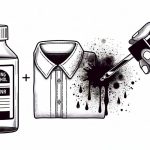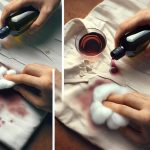Do you ever find yourself with stubborn stains on your clothes that just won’t come out? If so, you may have heard that rubbing alcohol can be a useful solution for removing tough stains. However, you may also be wondering if using rubbing alcohol on your clothes could cause damage or discoloration.
The good news is that rubbing alcohol can be a safe and effective solution for removing stains from many types of fabrics. However, it’s important to understand the properties of rubbing alcohol and to take certain precautions to avoid damaging your clothes.
In this article, we’ll explore the properties of rubbing alcohol, identify fabrics that can be harmed by rubbing alcohol, and provide tips for safe and effective use of rubbing alcohol on clothes.
Table of Contents
Understanding the Properties of Rubbing Alcohol
Rubbing alcohol, with its high evaporation rate and ability to dissolve substances, can potentially damage clothes if not used properly. It’s important to understand the properties of rubbing alcohol before using it on your clothes.
Rubbing alcohol is a solvent, meaning it can dissolve substances like oils, greases, and waxes. It’s also highly volatile, which means it evaporates quickly.
When using rubbing alcohol on clothes, it’s important to dilute it with water to avoid damaging the fabric. Use a ratio of one part rubbing alcohol to three parts water to create a safe and effective solution. Be sure to test the solution on a small, inconspicuous area of the garment before applying it more broadly.
If you do accidentally spill rubbing alcohol on your clothes, it’s important to act quickly. Blot the spill with a clean, dry cloth to remove as much of the liquid as possible. Then, rinse the area with cold water and blot it dry again. Avoid rubbing the area, as this can cause further damage to the fabric.
With the right precautions and quick action, you can safely use rubbing alcohol on your clothes without causing damage.
Identifying Fabrics That Can Be Harmed by Rubbing Alcohol
You should be careful with certain types of fabric when using this solution, as it can cause unexpected reactions that may leave you feeling frustrated and disappointed with the results.
Some fabrics may be more susceptible to discoloration or damage when exposed to rubbing alcohol. These fabrics include:
-
Acetate: This fabric is often used for formal wear and blends well with other fabrics. However, it’s highly vulnerable to damage from rubbing alcohol, which can cause it to dissolve or disintegrate.
-
Rayon: Although this fabric is commonly used in clothing, it can be easily damaged by rubbing alcohol. It may cause the fabric to shrink or lose its shape altogether.
-
Silk: Silk is a delicate fabric that requires special care. When exposed to rubbing alcohol, it can become discolored or even dissolved.
-
Leather: While not technically a fabric, leather is a material commonly used in clothing and accessories. Rubbing alcohol can cause it to crack or fade, leading to unsightly damage that may be difficult to repair.
It’s important to be aware of the potential risks when using rubbing alcohol on certain types of fabric. By identifying which fabrics are more vulnerable to damage, you can take the necessary precautions to avoid ruining your favorite clothes or accessories. If in doubt, always test a small, inconspicuous area first before applying rubbing alcohol to the entire garment or item.
Preparing Your Clothes for Rubbing Alcohol Application
Before applying rubbing alcohol to your clothes, it’s important to prepare them properly. This involves spot testing in an inconspicuous area to ensure the fabric can withstand the alcohol.
Additionally, pre-treating any stains on the garment before applying rubbing alcohol can help to maximize its effectiveness. Remember to take these steps to ensure your clothes remain in pristine condition.
Spot Testing
To ensure your clothes aren’t damaged, it’s best to spot test rubbing alcohol on a small, inconspicuous area first. This will help you determine if the alcohol will cause any discoloration or damage to the fabric. Simply apply a small amount of rubbing alcohol to the area and wait a few minutes to see if there are any adverse effects.
When spot testing, keep in mind that some fabrics may react differently to rubbing alcohol than others. For example, delicate fabrics like silk or wool may be more susceptible to damage. Additionally, certain dyes or prints may also be affected by the alcohol.
By taking the time to spot test, you can avoid ruining your entire garment and potentially save yourself from a costly mistake.
Pre-treating Stains
When dealing with stains, it’s helpful to pre-treat them before washing to ensure they come out completely. Rubbing alcohol can be a great pre-treatment solution for certain types of stains, such as ink or grass. Simply apply a small amount of rubbing alcohol directly onto the stain and let it sit for a few minutes before washing as usual. However, it’s important to note that rubbing alcohol shouldn’t be used on delicate fabrics or silk, as it can cause damage.
When pre-treating stains, it’s also important to consider the type of stain and the fabric. For example, protein-based stains, such as blood or sweat, should be pre-treated with cold water to prevent setting the stain. Grease-based stains, such as oil or butter, should be pre-treated with a solvent-based stain remover before washing.
For tough stains, it’s always a good idea to consult a professional cleaner or use a specialized stain remover product. By taking the time to pre-treat stains, you can ensure that your clothes come out looking clean and fresh every time.
Applying Rubbing Alcohol to Clothes
When applying rubbing alcohol to clothes, you can use a spray bottle to evenly distribute the alcohol onto the fabric. Alternatively, you can use a clean cloth to dab the rubbing alcohol onto the affected area.
If you’re worried about rubbing alcohol damaging your clothes, you can dilute it with water before use.
Using a Spray Bottle
Using a spray bottle with rubbing alcohol can be an effective way to remove stains, but it’s important to test a small, inconspicuous area first to ensure that the alcohol doesn’t damage the fabric. To use this method, mix equal parts water and rubbing alcohol in a spray bottle and spray the stained area. Allow the solution to sit for a few minutes, then blot the stain with a clean cloth.
Before using this method, it’s important to note that rubbing alcohol can damage certain fabrics, such as silk or acetate. To determine if your fabric is safe to use with rubbing alcohol, test a small area first and wait for any discoloration or damage to appear. The table below provides a helpful guide for which fabrics are safe to use with rubbing alcohol and which ones should be avoided. By testing a small area first and consulting the table, you can effectively remove stains without damaging your clothes.
| Safe to use with rubbing alcohol | Avoid using with rubbing alcohol |
|---|---|
| Cotton | Silk |
| Polyester | Acetate |
| Wool | Rayon |
| Nylon | Leather |
Using a Clean Cloth
To effectively remove the stain, grab a clean cloth and gently blot the area, being careful not to rub or smear the stain further into the fabric. This method works well for small stains that haven’t set into the fabric yet.
Simply apply a small amount of rubbing alcohol onto the clean cloth and dab at the stain until it starts to lift. Make sure to use a white or light-colored cloth to avoid any potential color transfer onto your clothes.
It’s important to remember to be gentle when using rubbing alcohol on your clothes as it can damage certain fabrics. Once the stain has been removed, rinse the area with water and let it air dry.
This method is a great alternative to using a spray bottle and can be just as effective when done correctly.
Diluting Rubbing Alcohol
One way to make rubbing alcohol less harsh on fabrics is by diluting it with water. This can be done by mixing equal parts rubbing alcohol and water in a spray bottle and testing it on a small, inconspicuous area of the fabric before using it on a larger surface.
It’s important to note that diluting rubbing alcohol can reduce its effectiveness as a disinfectant, so it may not be the best option for cleaning heavily soiled or germ-infested items. If you do decide to dilute rubbing alcohol, it’s important to use distilled water instead of tap water.
Tap water can contain minerals and impurities that can leave behind stains or damage the fabric. Additionally, be sure not to oversaturate the fabric when using the diluted rubbing alcohol solution. Using too much of the solution can cause the fabric to become saturated and potentially damage it.
By diluting rubbing alcohol, you can make it safer to use on your clothes, but it’s important to take precautions and test it on a small area first.
Removing Stains with Rubbing Alcohol
So, you want to know how to remove stains with rubbing alcohol? Well, there are a variety of stains that can be removed with this solution. You can remove ink, grass, and grease stains with rubbing alcohol.
To effectively remove these stains, it’s important to use the right techniques. Make sure to dab the affected area and avoid rubbing too hard. This will help prevent the stain from spreading and potentially causing more damage.
Types of Stains that Can Be Removed
You can easily remove stains like ink, grass, and grease from your clothes without worrying about rubbing alcohol damaging them. Rubbing alcohol is a great stain remover because it evaporates quickly and doesn’t leave a residue on your clothes.
For ink stains, simply pour a small amount of rubbing alcohol onto the stain and let it sit for a few minutes. Then, rub the stain with a cotton ball or cloth until it disappears.
For grass and grease stains, mix equal parts rubbing alcohol and water and apply the solution to the stain. Let it sit for a few minutes and then rinse with cold water.
Rubbing alcohol is also effective in removing nail polish, blood, and even some types of fruit juice stains. So, don’t be afraid to use it on your clothes.
Techniques for Stain Removal
To effectively remove stains, it’s important to know the right techniques. One of the most common methods is to pretreat the stain with a stain remover or detergent. Apply the product directly onto the affected area and let it sit for a few minutes before washing it as usual. For tough stains, you may need to repeat the process a few times.
Another technique is to soak the stained clothing in a solution of water and detergent or stain remover. Make sure the clothing is fully submerged and let it soak for at least 30 minutes to an hour. After soaking, rinse the clothing thoroughly and wash it as usual.
Remember to always check the care label before attempting any stain removal techniques to avoid damaging your clothes.
Caring for Your Clothes After Rubbing Alcohol Application
After applying rubbing alcohol, it’s important to take proper care of your clothes to prevent any damage. One way to do this is by washing the garment immediately after applying rubbing alcohol. This will ensure that any leftover residue is removed before it has a chance to set into the fabric.
When washing the garment, it’s important to follow the care instructions on the label. If the garment is machine washable, use a gentle cycle and a mild detergent. Avoid using hot water, as this can cause the alcohol to set into the fabric. If the garment is not machine washable, consider taking it to a professional cleaner who has experience with stain removal.
Once the garment is clean, inspect it for any signs of damage. Rubbing alcohol can be harsh on some fabrics, so it’s important to look for any discoloration, fading, or texture changes. If you notice any damage, consider taking the garment to a professional for repair or replacement.
By taking proper care of your clothes after applying rubbing alcohol, you can ensure that they stay in good condition for years to come.
Tips for Safe and Effective Use of Rubbing Alcohol on Clothes
Using rubbing alcohol on your clothes can be safe and effective if done correctly. So, it’s important to follow these tips:
-
Always test a small, inconspicuous area of the fabric before applying rubbing alcohol to the entire garment. This will ensure that the fabric can withstand the alcohol without causing any damage or discoloration.
-
Make sure to dilute the rubbing alcohol with water before applying it to the garment. This will prevent the alcohol from being too harsh on the fabric and causing any damage. The recommended ratio is one part rubbing alcohol to three parts water.
-
Never apply rubbing alcohol directly onto the fabric. Instead, apply it to a clean, white cloth and then gently blot the stain or area that needs cleaning. This will prevent any excess rubbing alcohol from saturating the fabric and causing damage.
-
Always rinse the garment thoroughly with water after using rubbing alcohol to remove any remaining residue. This will prevent any discoloration or damage to the fabric over time.
By following these tips, you can safely and effectively use rubbing alcohol on your clothes without causing any damage.
- Recycling Nonwoven Fabrics: Is It Possible? - July 11, 2025
- Recycling Nonwoven Fabrics: Is It Possible? - July 11, 2025
- Recycling Nonwoven Fabrics: Is It Possible? - July 11, 2025




